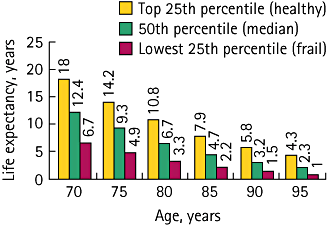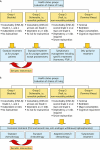Management of prostate cancer in older men: recommendations of a working group of the International Society of Geriatric Oncology
- PMID: 20346033
- PMCID: PMC3258484
- DOI: 10.1111/j.1464-410X.2010.09334.x
Management of prostate cancer in older men: recommendations of a working group of the International Society of Geriatric Oncology
Abstract
Prostate cancer is the most prevalent cancer in men and predominantly affects older men (aged >or=70 years). The median age at diagnosis is 68 years; overall, two-thirds of prostate cancer-related deaths occur in men aged >or=75 years. With the exponential ageing of the population and the increasing life-expectancy in developed countries, the burden of prostate cancer is expected to increase dramatically in the future. To date, no specific guidelines on the management of prostate cancer in older men have been published. The International Society of Geriatric Oncology (SIOG) conducted a systematic bibliographic search based on screening, diagnostic procedures and treatment options for localized and advanced prostate cancer, to develop a proposal for recommendations that should provide the highest standard of care for older men with prostate cancer. The consensus of the SIOG Prostate Cancer Task Force is that older men with prostate cancer should be managed according to their individual health status, which is mainly driven by the severity of associated comorbid conditions, and not according to chronological age. Existing international recommendations (European Association of Urology, National Comprehensive Cancer Network, and American Urological Association) are the backbone for localized and advanced prostate cancer treatment, but need to be adapted to patient health status. Based on a rapid and simple evaluation, patients can be classified into four different groups: 1, 'Healthy' patients (controlled comorbidity, fully independent in daily living activities, no malnutrition) should receive the same treatment as younger patients; 2, 'Vulnerable' patients (reversible impairment) should receive standard treatment after medical intervention; 3, 'Frail' patients (irreversible impairment) should receive adapted treatment; 4, Patients who are 'too sick' with 'terminal illness' should receive only symptomatic palliative treatment.
Figures



Comment in
-
Re: management of prostate cancer in older men: recommendations of a working group of the International Society of Geriatric Oncology.J Urol. 2011 Feb;185(2):520. doi: 10.1016/S0022-5347(11)60136-5. J Urol. 2011. PMID: 22088633 No abstract available.
Similar articles
-
A comment on the International Society of Geriatric Oncology guidelines: evidence-based advice for the clinical setting.Oncologist. 2012;17 Suppl 1(Suppl 1):31-5. doi: 10.1634/theoncologist.2012-S1-31. Oncologist. 2012. PMID: 23015683 Free PMC article.
-
Updated recommendations of the International Society of Geriatric Oncology on prostate cancer management in older patients.Eur J Cancer. 2019 Jul;116:116-136. doi: 10.1016/j.ejca.2019.04.031. Epub 2019 Jun 10. Eur J Cancer. 2019. PMID: 31195356 Review.
-
Background for the proposal of SIOG guidelines for the management of prostate cancer in senior adults.Crit Rev Oncol Hematol. 2010 Jan;73(1):68-91. doi: 10.1016/j.critrevonc.2009.09.005. Crit Rev Oncol Hematol. 2010. PMID: 19836968 Review.
-
Management of Prostate Cancer in Elderly Patients: Recommendations of a Task Force of the International Society of Geriatric Oncology.Eur Urol. 2017 Oct;72(4):521-531. doi: 10.1016/j.eururo.2016.12.025. Epub 2017 Jan 11. Eur Urol. 2017. PMID: 28089304 Review.
-
Management of prostate cancer in older patients: updated recommendations of a working group of the International Society of Geriatric Oncology.Lancet Oncol. 2014 Aug;15(9):e404-14. doi: 10.1016/S1470-2045(14)70018-X. Lancet Oncol. 2014. PMID: 25079103 Review.
Cited by
-
The Latest Data Specifically Focused on Long-Term Oncologic Prognostication for Very Old Adults with Acute Vulnerable Localized Prostate Cancer: A Nationwide Cohort Study.J Clin Med. 2022 Jun 15;11(12):3451. doi: 10.3390/jcm11123451. J Clin Med. 2022. PMID: 35743522 Free PMC article.
-
A comment on the International Society of Geriatric Oncology guidelines: evidence-based advice for the clinical setting.Oncologist. 2012;17 Suppl 1(Suppl 1):31-5. doi: 10.1634/theoncologist.2012-S1-31. Oncologist. 2012. PMID: 23015683 Free PMC article.
-
[Geriatric assessment prior to oncological therapy].Urologe A. 2013 Jun;52(6):827-31. doi: 10.1007/s00120-013-3212-7. Urologe A. 2013. PMID: 23708006 German.
-
Feasibility of cabazitaxel in octogenarian prostate cancer patients.Curr Urol. 2023 Sep;17(3):153-158. doi: 10.1097/CU9.0000000000000081. Epub 2022 Aug 2. Curr Urol. 2023. PMID: 37448615 Free PMC article.
-
Development of an oncological-multidimensional prognostic index (Onco-MPI) for mortality prediction in older cancer patients.J Cancer Res Clin Oncol. 2016 May;142(5):1069-77. doi: 10.1007/s00432-015-2088-x. Epub 2016 Jan 12. J Cancer Res Clin Oncol. 2016. PMID: 26758276 Free PMC article.
References
-
- Jemal A, Siegel R, Ward E, et al. Cancer statistics 2008. CA Cancer J Clin. 2008;58:71–96. - PubMed
-
- Ferlay J, Autier P, Boniol M, et al. Estimates of cancer incidence and mortality in Europe in 2006. Ann Oncol. 2007;18:581–92. - PubMed
-
- Ries LAG, Melbert D, Krapcho M, et al. SEER Cancer Statistics Review, 1975–2005. Bethesda, MD: National Cancer Institute; 2008. Available at: http://seer.cancer.gov/csr/1975-2005/, based on December 2009 SEER data submission, posted to the SEER web site 2008. Accessed 19 December 2009.
-
- Heidenreich A, Aus G, Bolla M, et al. EAU guidelines on prostate cancer. Eur Urol. 2008;53:68–80. - PubMed
-
- National Comprehensive Cancer Network. NCCN Clinical Practice Guidelines in Oncology: Prostate Cancer V.2. 2009 Available at: http://www.nccn.org/professionals/physician_gls/f_guidelines.asp. Accessed December 2009. - PubMed
Publication types
MeSH terms
LinkOut - more resources
Full Text Sources
Other Literature Sources
Medical

